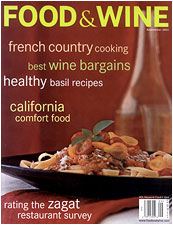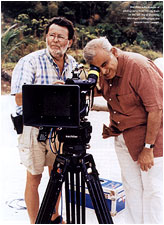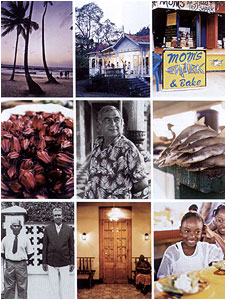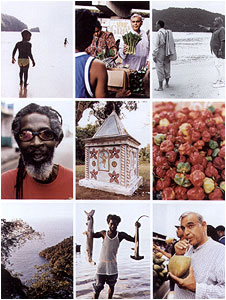Ismail Merchant's TRINIDAD
 Who
makes the best kingfish bus-up-shut in the Caribbean? Ismail Merchant
knows. As location shooting on his upcoming movie wraps, the filmmaker
leads a tour of Trinidad's wild, multicultural food scene. Who
makes the best kingfish bus-up-shut in the Caribbean? Ismail Merchant
knows. As location shooting on his upcoming movie wraps, the filmmaker
leads a tour of Trinidad's wild, multicultural food scene.
By Tama Janowitz Photographs by Roy Zipstein
"You
must come to Trinidad!" Ismail Merchant shouts over the phone. He
is already there, directing his fifth film, this one based on V. S.
Naipaul's 1957 comic novel The Mystic Masseur. "It's fantastic
- the scenery, the people. And the food is unbelievable!"
The producer half (usually)
of the Merchant Ivory team, Ismail is also the author of several cookbooks
and is one of the world's great home cooks. One weekend, when I was
visiting him and director James Ivory at their home in Claverack, New
York, he got into an argument with another guest over how best to prepare
fresh goose. Ismail won the debate, threw two huge geese into the oven
and disappeared. After several hours, during which, apart from a few
minutes early on, he never set foot in the kitchen, he announced that
lunch-for 20-was served: dal, rice, green beans Indian-style, stuffing
and two perfect geese. If Ismail tells me the food somewhere is unbelievable,
I listen. And if Ismail says come to Trinidad, then that's where I find
myself a few weeks later.
By the time I arrive at
the housing complex just outside Port of Spain where Ismail has been
camped along with some of the crew, it's too late for dinner, but Ismail
groggily ushers me in and, almost instantly, squeezes some oranges and
adds Trinidadian rum to make the most delicious cocktail I've ever tasted.
Then, in spite of the hour, Ismail decides to screen the rushes from
the last few days of filming.
 |
|
Merchant with director
of photography Ernie Vincze. Even on the last day of shooting,
Merchant's enthusiasm and passion hadn't waned.
|
"This scene came out wonderfully!"
he tells me.
"Which scene is it?"
"The one where the man
makes love to his bicycle!"
It's true. In take after
take, beautifully shot in the middle of a lush banana grove, a man passionately
strokes the seat of an antique bicycle. Then the mystic masseur arrives
and blesses the man, who is finally able to break off his relationship
with the bike. "I thought of this scene myself," Ismail says. "We had
to devise a special pump to make the bicycle appear to throb. Never
before has a Merchant Ivory film shown a man having sex with his bicycle!"
"But Ismail," I said,
"what's Naipaul going to say?"
The notoriously prickly
author was born and raised in Trinidad by parents from northern India.
The Mystic Masseur, the story of a young man who climbs the ladder
of fame through a combination of mysticism and political ambition, is
set among the island's large Indian community.
"Do you know," Ismail
says, "this is the only time Naipaul has permitted anyone to make a
film from one of his books. I called him up, and I offered to send him
one of my films and to go see him at his country house. He wrote a letter
back that said, 'Dear Ismail, your persuasive powers are legendary.
You have my permission.'"
The next morning, Ismail
takes me to the Breakfast Shed, a huge barn where Port of Spain's working
people come to eat breakfast (and, sometimes, lunch and dinner). In
the center of the room, rows of large picnic tables have been covered
with old-fashioned oilcloth; around the edges are cooking stalls rented
by women. Ismail wanders around the room, admiring their techniques.
One woman is shaving coconut with a hand-cranked grater; another is
chopping okra. Each vies for our attention. "Sit here! Sit here!" they
call, trying to lure us to their stalls.
I puzzle over the menu
posted on the wall (FRY BAKE, ROAST BAKE, FRY FISH BULJOL, SMOKE HERRING,
FISH BROTH) with shock and disbelief.
 |
| Ismail Merchant,
center, in the thick of things in Trinidad. Clockwise from top right:
a local snack stand; one of the two ingredients in shark-and bake;
island girls at the Breakfast Shed; waiting for dinner; two well-dressed
Trinidadians; hibiscus blossoms at the Central Market; sunset at
Maracas Bay; Merchant's tea party at a country house that appears
in the film. |
"What about toast?" I
whimper. Breakfast, to me, is a limited meal punctuated by coffee at
one end and eggs at the other. Finally I see some stacks of small round
loaves in a glass case. "Could I get some of that bread?" I ask.
"It's not bread!" I'm
informed, rather roughly, by the stall's operator. "It's bake!"
"Well, OK then. Could
I have some bake?"
"You can't have just the
bake. You can only have bake-and-fish."
Whatever. At last we're
seated and platters of food begin to arrive, two portions of bake-and-fish
and several gigantic bowls of fish stew with bananas. I don't see how
I can eat fish stew at 9 a.m., but after one bite I'm completely hooked.
The bananas don't taste like bananas; they just add their rich, starchy
sweetness to already sweet chunks of fish. "Delicious," Ismail pronounces.
"It's a challenge to bouillabaisse. The French will have to think about
their recipe and come up with a new one, as the Trinidadian version
has surpassed all bouillabaisse in the world.
"And this bread, the bake
- it's Indian, an adaptation of a South Indian crusty bun, which also
has grated coconut, but not the fish on the side," Ismail, a native
of Bombay, says appreciatively. "It's so interesting that a recipe brought
here hundreds of years ago by Indian workers has, over time, become
quite different from the original."
Ismail gets into a conversation
with the man sitting next to us, who explains that we are eating what,
on the island, is called "African food." Over the centuries, Trinidad
has been inhabited by a wide range of people - Spanish, African, French,
British, Indian, Portuguese, Chinese, Syrian, Lebanese, Venezuelan -
and both the culture and the food manage, remarkably, to reflect all
these influences. "The different cuisines have been blended together,
so you find everything made in new ways, with the addition of local
products," Ismail says. "Only the Chinese food has remained unchanged;
the Chinese people who came here didn't like things to be different
from what they had in China."
By now I've changed my
mind completely about breakfast. Forget eggs and toast; this is a real
workman's cook-up. The fluffy little loaves of bake topped with huge,
fresh chunks of boneless kingfish seem to me to be Trinidad's equivalent
of bagels and lox.
Later we stop at the Merchant
Ivory production offices. The shooting is almost over, and only a few
of the crew are left, busily packing papers and equipment. Shahnaz Vahanvaty,
a costume designer, is selling off clothes from the movie - bright swathes
of Indian fabric as well as plainer clothing that Indians living in
Trinidad would have worn in the '40s and '50s, when the movie takes
place. I score a piece of a sari, in pink and gold chiffon, that was
used in The Mystic Masseur but dates back to Heat and Dust,
made in 1982. Everything in a Merchant Ivory production is scrounged,
recycled, put together from bits and pieces. This, in part, explains
how the films look so lavish when the budgets are usually minuscule.
Another reason, though, is Ismail's impressive talent for cajoling,
wooing, begging, befriending. In his few months here, he's become connected
to everyone on the island, which is how he's been able to shoot in locations
that would have been off-limits to anyone else. Prime Minister Basdeo
Panday, for example, allowed Ismail to film in his office.
 |
| Clockwise from top left:
On the beach; Merchant inspects the local produce; directing the
film's star, Aasif Mandvi; fiery chiles at the market; Merchant
cools down with fresh coconut water; a fisherman and his wares;
looking down onto Maracas Bay; a Port of spain resident. Center:
a Hindu shrine built for the film.
|
Later on, we visit the
Central Market, where we find the most remarkable fruits, vegetables
and fish I have ever seen. Ismail is wandering around the stalls and
trucks with great interest, talking to all the vendors. The trucks are
filled with small, perfect pineapples, oranges (Ismail buys a hundred
for about five dollars), cauliflower, bunches of neatly tied dasheen
(a green similar to spinach, with long, pointed leaves, used in soups
and stews), deep-ruby-red tomatoes, bananas, bitter Chinese winter melons,
coconuts and huge round balls of chocolate. Trinidadian chocolate is
marvelous, but very little is exported. It's often mixed with hot water,
milk and sugar to make a hot drink the locals call chocolate tea. I
buy three or four pounds for three dollars; the scent is so pungent
that within hours it has permeated my clothes and hair. I don't know
whether I'm more drugged by this or by the mesmerizing scent of chadon
beni, an herb used in many local dishes. Imagine the smell of cilantro
intensified five hundred times and you begin to get the idea of chadon
beni.
The next day I head out
with Ismail and his nephew Nayeem Hafizka to one of the local roti shops,
a favorite among the crew, called Paratha. Roti, traditionally made
by women for their husbands to take out into the sugarcane fields, is
a meal wrapped up in a thin piece of Indian bread. Fillings are posted
up on the wall: conch, duck, goat, chicken, beef or vegetables. You
pay two or three dollars and watch as a cafeteria worker begins to organize
your roti, adding other elements to order, like braised bok choi, stewed
pumpkin, spiced channa (chickpeas), mango kuchela (a chutney made from
green mangos, garlic, hot peppers and spices) and so forth. We try one
boneless-chicken roti and one kingfish bus-up-shut. The bus-up-shut
is similar to a roti but uses a flakier, richer flat bread and is served
open-faced rather than rolled up (hence the name, which comes from "burst-open
shirt"). By now, I am starting to see that Trinidad is one of the only
places in the Caribbean that is not so much a haven for tourists as
a place to try a mix of food found nowhere else in the world.
In the afternoon, Ismail
takes me to see some of the locations in the movie. We drive into the
countryside, past palm and banana trees, up through the mountains to
a complex of tiny cottages. "Here is where the mystic masseur grew up,
and here, in this hut by the tree - we believe it to be nearly two hundred
years old - his disciples came for darshan, an audience with
the master." Finally we arrive at a huge, ornate farmhouse. The house,
greatly deteriorated and utterly charming, was built more than 150 years
ago by a wealthy Anglo-German baron who settled here to farm cocoa.
It is now owned by his descendants, who seem to have changed next to
nothing in all that time. The original four-poster beds, an old music
box the size of a grandfather clock, a bathing pool fed by fresh springs
and streams - all are still in place.
"It is here that the mystic
masseur comes to live after he becomes wealthy!" Ismail says. "And now
we will have a tea party." From out of nowhere appear cucumber and tomato
sandwiches, tea and a herd of guests - a young American couple who are
in the foreign service; Nayeem and his wife, Parvena, a production photographer;
Ismail's niece, Rahila Bootwala, the production accountant, and her
baby Alina, among others� all bringing cakes and linens, silverware
and china.
"Isn't this wonderful?"
Ismail asks, gesturing with his tea cup. "We must all come back for
the opening of The Mystic Masseur in November." He's dauntless,
even after months of rising at dawn, struggling to make a film in a
place that takes its own time about doing things, working around all
sorts of chaotic, nightmarish situations, including a brief political
crisis. His enthusiasm, his passion and his sense of fun don't seem
to have waned. And, sitting on this crumbling porch, in the fading light
of a tropical afternoon, looking out across mountains covered with jungle,
I decide that the most sensible thing I could do would be to buy this
wreck of a house, or one just like it, and move to Trinidad. Come back
in November? Whatever you say, Ismail.
Tama Janowitz is the
author of seven books, the most recent of which is a story for very
young children called Hear That?
This
article originally appeared in September 2001 .
|